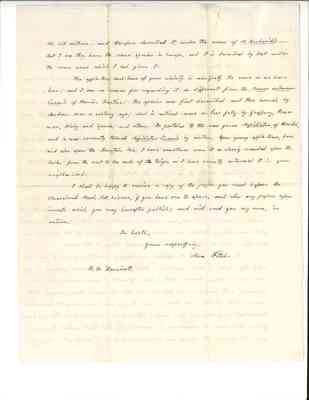Pages
1
Fitch's Point ( East Greenwich P.O.) Washington Co. N.Y. October 25th 1854. My Dear Sir:- In the cottony mass which you have the kindness to send me, I am unable to find anything but fragments too broken and pressed out of shape to throw much light upon the species which produced this substance. I however find one entire scale, of a regular oval form, three hundreths of an inch in length and half as much in breadth, of a dirty yellowish color, with an elevated line in the middle of the back. This is in all probability the relicts pupa, being so very like the pupa of other species of this family. Fabricius describes a Coccus inhabiting the common fig, a tree so closely related to the Osage Orange that it is at least questionable whether the insect upon the latter may not be the same species. He describes it as roundish, of a ferruginous color, with a paler, elevated margin. Some of the larger fragments in the mass you send me, appear colored as described, but they are so pressed and flattened that I cannot ascertain whether the margin is elevated. The old genus coccus is now divided into eleven genera. Most of the bark-lice on the trees and shrubs of this country pertain to the modern genus Lecanium - and this Osage Orange insect probably belongs to this genus. The mode in which the Aphidae and Coccidae sometimes get to the vegetation which they infest, is truly mysterious. Some years ago a tamerack growing in my front yard became overrun with a louse, of which I could never find an individual with wings: - and there are no other Tamerack Trees growing within several miles of this. A barberry bush in my yard was brought here from Connecticut some 50 years ago, and is the only one I know of in this region. Yet an Aphis made its appearance, in numbers, on this bush, about ten years ago. I supposed this was a new species, not finding it mentioned in any of
2
the old authors, and therefore described it, under the name of A.Berberidis - But I see they have the same species in Europe, and it is described by Kalt under the same name which I had given it. The apple-tree bark-louse of your vicinity is manifestly the same as we have here; and I see no reason for regarding it as different from the Cossus arborum - linearis of Harris's Treatise. The species was first described and thus named, by Modeer, over a century ago; and is noticed more or less fully by Geoffroy, Redumer, Kirby and Spence, and others. It pertains to the new genus Aspidiotus of Bouche (accent over e), and is now currently termed Aspidiotus linearis by writers. Upon young apple-trees, here, and also upon the Mountain Ash, I have sometimes seen it as closely crowded upon the bark, from the root to the ends of the twigs, as I have recently witnessed it in your neighborhood. I shall be happy to receive a copy of the paper you read before the Cleaveland Acad. Nat. Sciences, if you have one to spare, and also any papers upon insects which you may hereafter publish; and will send you my own, in return. In haste, Yours respectfully, Asa Fitch, R.W. Kennicott

